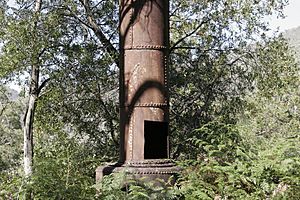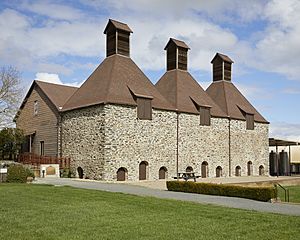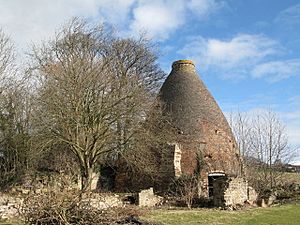Kiln facts for kids
A kiln, originally pronounced "kill", with the "n" silent, is a thermally insulated chamber, a type of oven, that produces temperatures sufficient to complete some process, such as hardening, drying, or chemical changes.
Kilns have been used for millennia to turn objects made from clay into pottery, tiles and bricks. Various industries use rotary kilns for pyroprocessing—to calcinate ores, to calcinate limestone to lime for cement, and to transform many other materials.
Uses of kilns
Pit fired pottery was produced for thousands of years before the earliest known kiln, which dates to around 6000 BC, and was found at the Yarim Tepe site in modern Iraq. Neolithic kilns were able to produce temperatures greater than 900 °C (1652 °F).
Uses include:
- Annealing, fusing and deforming glass, or fusing metallic oxide paints to the surface of glass
- Heat treatment for metallic workpieces
- Ceramics
- Brickworks
- Melting metal for casting
- Smelting ore to extract metal
- Pyrolysis of chemical materials
- Heating limestone with clay in the manufacture of Portland cement, the Cement kiln
- Heating limestone to make quicklime or calcium oxide, the Lime kiln
- Heating gypsum to make plaster of Paris
- For cremation (at high temperature)
- Drying of tobacco leaves
- Drying malted barley for brewing and other fermentations
- Drying hops for brewing (known as a hop kiln or oast house)
- Drying corn (grain) before grinding or storage
- Drying green lumber so it can be used immediately
- Drying wood for use as firewood
- Heating wood to the point of pyrolysis to produce charcoal
Images for kids
-
Charcoal kiln in California
-
Hops kiln
-
During the reconstitution of a traditional Cambodian kiln at Khmer Ceramics & Fine Arts Centre in Siem Reap, Cambodia
-
A wood fired pottery kiln in Hội An, Vietnam.
-
A two-story porcelain kiln with furnaces á alandier in Sèvres, France circa 1880
See also
 In Spanish: Kiln para niños
In Spanish: Kiln para niños















